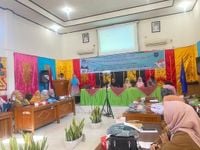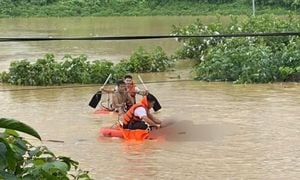In today's interconnected and competitive world, mastering multiple languages is no longer a luxury but a necessity. This global shift is evident in education systems worldwide, including Indonesia, where multilingual literacy is increasingly recognized for its cognitive and cultural benefits. According to the UNESCO Global Education Monitoring Report (2023), 37% of primary education systems in developing countries have integrated bilingual approaches to improve literacy and numeracy outcomes. This trend reflects a deeper scientific understanding that bilingualism enhances cognitive control, decision-making, and flexibility in thinking, as demonstrated by Ellen Bialystok's 2001 research and a 2021 longitudinal study published in Frontiers in Psychology.
Indonesia, with its rich multilingual environment, sees many children grow up speaking a mother tongue at home, Bahasa Indonesia at school, and foreign languages through digital media. However, the national education system has yet to fully embrace this reality. Foreign languages remain supplementary rather than integral to early learning, despite evidence that multilingual approaches strengthen foundational literacy and foster tolerance. Indonesian Language Education and Culture Studies (ILECS, 2022) found that 78% of children aged 3 to 7 in bilingual settings do not experience language confusion when consistent language use is maintained across contexts.
One shining example of successful multilingual education is seen in Yogyakarta. A 2024 report by Kemdikbudristek highlights a trilingual, project-based learning model in elementary schools that significantly improved reading and writing skills across all three languages taught. Yet, the rapid rise of digital technology presents a double-edged sword. Children aged 6 to 12 spend an average of 2.7 hours daily watching videos, with 40% of this content in foreign languages, according to the Digital 2024: Indonesia report by We Are Social and Meltwater. Without adult guidance, this exposure risks superficial imitation rather than deep comprehension, underscoring the need for balanced multilingual and digital literacy education.
Importantly, multilingual literacy does not mean sidelining the mother tongue. UNICEF Indonesia's 2022 report underscores that mother tongue-based education in early years reduces dropout rates and increases student participation in multilingual regions like Papua and East Nusa Tenggara. The government and schools have the opportunity to adopt contextual approaches combining regional, national, and global languages tailored to children's environments. While some schools have begun implementing bilingual and trilingual methods, scaling these efforts requires policy support, teacher training, development of multilingual teaching materials, and public campaigns to raise awareness of the benefits.
Parallel to these educational initiatives, language preservation programs are gaining momentum, particularly for regional languages facing extinction. The Indonesian Agency for Language and Literature Development and Cultivation (BBPSB) has launched the Regional Language Revitalization (RBD) program, mandated by Articles 41 and 42 of Law No. 24 of 2009. In West Sumatra, the focus is on revitalizing the Minangkabau language, targeting 'guru utama' or main teachers who can cascade their knowledge to peers and students. Rahmat, Head of Balai and Kantor Bahasa Sumbar, shared on June 9, 2025, that the program is in its second year, with 18 activities planned through August 2025—an increase from five activities last year.
The RBD program includes technical guidance (Bimtek) to enhance the competence of these main teachers in teaching and preserving Minangkabau. The training, conducted across all 18 regencies and cities in West Sumatra from May to August 2025, involves 40 participants per location, comprising elementary and junior high teachers as well as education department staff. Five expert trainers employ a Trainer of Trainer (TOT) method, covering writing stories, storytelling, pantun poetry, traditional singing, and public speaking. Trainer Jawahir noted that this year's training dives deeper with improved, more efficient modules compared to the previous year.
This comprehensive approach aims not only to preserve the Minangkabau language and literature but also to create creative spaces for young speakers to use and develop their language in daily life. The next activity is scheduled for Padang Panjang city from June 11 to 13, 2025.
Meanwhile, inspiring youth like Mochamad Dava Hibrawardana from East Java are taking language preservation into the digital age. After participating in the Kange Yune Bojonegoro 2023 and winning the Favorite Male Winner title at the East Java Language Ambassador 2025 competition, Dava has championed 'Lelana Bahasa,' a digital initiative promoting East Java's languages and culture. This interactive website features an Indonesian-to-Javanese dictionary (covering ngoko, madya, and krama levels), a collection of folk tales, and cultural information about East Java's regencies and cities, accessible to students, teachers, and the general public.
Dava, a 21-year-old student at Universitas Airlangga's Faculty of Language and Business, emphasizes the challenge posed by the dominance of foreign languages online. With 210 million Indonesians using the internet and 95% accessing it via gadgets, as reported by the Indonesian Internet Service Providers Association in 2024, local languages risk being overshadowed. His digital platform aims to rekindle love for Bahasa Indonesia and Javanese by leveraging technology as a relevant educational tool for today's youth.
At the same time, urban language culture is evolving in intriguing ways. In Jakarta, particularly South Jakarta, young people have popularized 'Jaksel style,' a linguistic blend mixing Indonesian and English within conversations. Researchers like Nurhayana et al. (2023) observe that teenagers frequently mix Indonesian, English, Arabic, and Sundanese online as forms of self-expression and social interaction. Adani (2024) explains that such code-mixing fosters casual atmospheres and closeness among peers, while Iftitah et al. (2022) note its prevalence in informal social media contexts among youth.
Jaksel style reflects a cosmopolitan urban identity but also raises questions about its impact on the richness and unity of Bahasa Indonesia. Is it merely a trendy social marker or a genuine cultural shift? This linguistic phenomenon illustrates how language is both fluid and central to identity, balancing tradition with globalization.
Altogether, these developments paint a complex picture of Indonesia's language landscape in 2025. From policies revitalizing regional tongues like Minangkabau, to youth-led digital preservation efforts, to the dynamic urban vernacular of Jakarta's youth, the nation is navigating the challenges and opportunities of multilingualism and cultural preservation in a digital age.
Multilingual literacy and language preservation are not just academic concerns but vital investments in Indonesia's social cohesion, cultural richness, and global engagement. As educators, policymakers, and communities continue to innovate and adapt, the future promises a generation of Indonesians who are not only fluent communicators but also proud custodians of their linguistic heritage.




